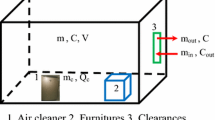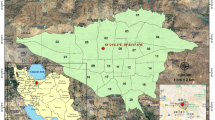Abstract
Air infiltration is an important way to exchange indoor air with outdoors. It significantly impacts energy consumption and air quality of buildings. Fine particles (PM2.5) in the outdoor atmosphere environment are a potential natural tracer for the measurement of air infiltration rate, especially in the long term field measurement. In this study, a PM2.5-based method, named as CADR (clean air delivery rate) method, is developed to supplement traditional tracer gas method in order to make routine measurement in realistic environments possible and convenient. An air cleaner is installed indoors to reduce indoor PM2.5 concentration. Air infiltration is determined by fitting a model to the decreasing concentration data. Comparison with CO2 decay method in four different indoor environments gives a normalized mean error of 19% and a correlation coefficient of 0.80 for this method. This justifies the CADR method as a feasible option to measure air infiltration rate. Although subject to several constraints, the proposed method would facilitate field measurement under realistic conditions by being combined with current tracer gas methods.
Similar content being viewed by others
References
Batterman S (2017). Review and extension of CO2-based methods to determine ventilation rates with application to school classrooms. International Journal of Environmental Research and Public Health, 14: 145.
Bekö G, Gustavsen S, Frederiksen M, Bergsøe NC, Kolarik B, et al. (2016). Diurnal and seasonal variation in air exchange rates and interzonal airflows measured by active and passive tracer gas in homes. Building and Environment, 104: 178–187.
Cao S-J, Ren C (2018). Ventilation control strategy using low-dimensional linear ventilation models and artificial neural network. Building and Environment, 144: 316–333.
Castillo JA, Huelsz G, van Hooff T, Blocken B (2019). Natural ventilation of an isolated generic building with a windward window and different windexchangers: CFD validation, sensitivity study and performance analysis. Building Simulation, 12: 475–488.
Cheng PL, Li X (2018). Air infiltration rates in the bedrooms of 202 residences and estimated parametric infiltration rate distribution in Guangzhou, China. Energy and Buildings, 164: 219–225.
Diapouli E, Chaloulakou A, Koutrakis P (2013). Estimating the concentration of indoor particles of outdoor origin: A review. Journal of the Air & Waste Management Association, 63: 1113–1129.
Dong B, Yan D, Li Z, Jin Y, Feng X, et al. (2018). Modeling occupancy and behavior for better building design and operation—A critical review. Building Simulation, 11: 899–921.
Fisk WJ (2018). How home ventilation rates affect health: A literature review. Indoor Air, 28: 473–487.
Fortenberry C, Walker M, Dang A, Loka A, Date G, et al. (2019). Analysis of indoor particles and gases and their evolution with natural ventilation. Indoor Air, 29: 761–779.
Gołofit-Szymczak M, Górny RL (2018). Microbiological air quality in office buildings equipped with different ventilation systems. Indoor Air, 28: 792–805.
Hänninen OO, Lebret E, Ilacqua V, Katsouyanni K, Künzli N, et al. (2004). Infiltration of ambient PM2.5 and levels of indoor generated non-ETS PM2.5 in residences of four European cities. Atmospheric Environment, 38: 6411–6423.
Hou J, Zhang Y, Sun Y, Wang P, Zhang Q, et al. (2018). Air change rates at night in northeast Chinese homes. Building and Environment, 132: 273–281.
Hou J, Sun Y, Chen Q, Cheng R, Liu J, et al. (2019). Air change rates in urban Chinese bedrooms. Indoor Air, 29: 828–839.
JGJ/T461-2019 (2019). Design Standard for Controlling Indoor Air Quality of Public Building. Ministry of Housing and Urban-Rural Development of China. Beijing: China Architecture & Building Press. (in Chinese)
Ji W, Zhao B (2015). Contribution of outdoor-originating particles, indoor-emitted particles and indoor secondary organic aerosol (SOA) to residential indoor PM2.5 concentration: A model-based estimation. Building and Environment, 90: 196–205.
Johnston CJ, Andersen RK, Toftum J, Nielsen TR (2020). Effect of formaldehyde on ventilation rate and energy demand in Danish homes: Development of emission models and building performance simulation. Building Simulation, 13: 197–212.
Li A, Hou Y, Yang J (2019). Attached ventilation based on a curved surface wall. Building Simulation, 12: 505–515.
Licina D, Tian Y, Nazaroff WW (2017). Emission rates and the personal cloud effect associated with particle release from the perihuman environment. Indoor Air, 27: 791–802.
Liu C, Zhao B, Zhang Y (2010). The influence of aerosol dynamics on indoor exposure to airborne DEHP. Atmospheric Environment, 44: 1952–1959.
Liu C, Zhang Y, Benning JL, Little JC (2015). The effect of ventilation on indoor exposure to semivolatile organic compounds. Indoor Air, 25: 285–296.
Liu C, Yang J, Ji S, Lu Y, Wu P, Chen C (2018a). Influence of natural ventilation rate on indoor PM2.5 deposition. Building and Environment, 144: 357–364.
Liu Y, Misztal PK, Xiong J, Tian Y, Arata C, et al. (2018b). Detailed investigation of ventilation rates and airflow patterns in a northern California residence. Indoor Air, 28: 572–584.
Liu C, Miao X, Li J (2019a). Outdoor formaldehyde matters and substantially impacts indoor formaldehyde concentrations. Building and Environment, 158: 145–150.
Liu C, Wang H, Guo H (2019b). Redistribution of PM2.5-associated nitrate and ammonium during outdoor-to-indoor transport. Indoor Air, 29: 460–468.
Liu C, Zhang Y (2019). Relations between indoor and outdoor PM2.5 and constituent concentrations. Frontiers of Environmental Science & Engineering, 13: 5.
Marley W G (1935). The measurement of the rate of air change. Journal of the Institution of Heating & Ventilation Engineers, 2: 499–504.
Ni PY, Jin HC, Wang XL, Xi GN (2018). A new method for measurement of air change rate based on indoor PM2.5 removal. International Journal of Environmental Science and Technology, 15: 2561–2568.
Ohlsson KEA, Yang B, Ekblad A, Boman C, Nyström R, et al. (2017). Stable carbon isotope labelled carbon dioxide as tracer gas for air change rate measurement in a ventilated single zone. Building and Environment, 115: 173–181.
Persily AK (1997). Evaluating building IAQ and ventilation with indoor carbon dioxide. Transactions-American Society of Heating Refrigerating and Air Conditioning Engineers, 103: 193–204.
Persily A (2015). Challenges in developing ventilation and indoor air quality standards: The story of ASHRAE Standard 62. Building and Environment, 91: 61–69.
Persily AK (2016). Field measurement of ventilation rates. Indoor Air, 26: 97–111.
Qi MW, Li XF, Weschler LB, Sundell J (2014). CO2 generation rate in Chinese people. Indoor Air, 24: 559–566.
Qian M, Yan D, An J, Hong T, Spitler JD (2020). Evaluation of thermal imbalance of ground source heat pump systems in residential buildings in China. Building Simulation, 13: 585–598.
Remion G, Moujalled B, El Mankibi M (2019). Review of tracer gas-based methods for the characterization of natural ventilation performance: Comparative analysis of their accuracy. Building and Environment, 160: 106180.
Ren J, Cao S-J (2019). Incorporating online monitoring data into fast prediction models towards the development of artificial intelligent ventilation systems. Sustainable Cities and Society, 47: 101498.
Renbourn ET, Angus TC, Ellison JM, Croton LM, Jones MS (1949). The measurement of domestic ventilation: An experimental and theoretical investigation with particular reference to the use of carbon dioxide as a tracer substance. Journal of Hygiene, 47: 1–38.
Salvador CM, Bekö G, Weschler CJ, Morrison G, Le Breton M, et al. (2019). Indoor ozone/human chemistry and ventilation strategies. Indoor Air, 29: 913–925.
Sherman MH (1990). Tracer-gas techniques for measuring ventilation in a single zone. Building and Environment, 25: 365–374.
Shi Y, Li X, Li H (2017). A new method to assess infiltration rates in large shopping centers. Building and Environment, 119: 140–152.
Sundell J, Levin H, Nazaroff WW, Cain WS, Fisk WJ, et al. (2011). Ventilation rates and health: Multidisciplinary review of the scientific literature. Indoor Air, 21: 191–204.
Thatcher TL, Layton DW (1995). Deposition, resuspension, and penetration of particles within a residence. Atmospheric Environment, 29: 1487–1497.
Tian E, Mo J (2019). Toward energy saving and high efficiency through an optimized use of a PET coarse filter: The development of a new electrostatically assisted air filter. Energy and Buildings, 186: 276–283.
Tredgold T (1824). Principles of Warming and Ventilating Public Buildings: Dwelling Houses, Manufactories, Hospitals, Hot-houses, Conservatories, and of Constructing Fire-places, Boilers, Steam Apparatus, Grates, and Drying Rooms, with Illustrations Experimental, Scientific, and Practical, 2nd edn. London: Printed for J. Taylor.
Xu Z (2003). Principles of Air Cleaning Technology, 3rd edn. Beijing: Science press. (in Chinese)
Zhai S, Li Z, Zhao B (2014). State-space analysis of influencing factors on airborne particle concentration in aircraft cabins. Building and Environment, 74: 13–21.
Acknowledgements
Financial support was provided by the National Natural Science Foundation of China (No. 51808107), the National Key R&D Program of China (No. 2017YFC0702700), the Science and Technology Plan of Changzhou (No. CJ20190018), and the Fundamental Research Funds for the Central Universities (No. FRF-TP-18-025A2). The authors declared no potential conflicts of interest.
Author information
Authors and Affiliations
Corresponding authors
Rights and permissions
About this article
Cite this article
Liu, C., Ji, S., Zhou, F. et al. A new PM2.5-based CADR method to measure air infiltration rate of buildings. Build. Simul. 14, 693–700 (2021). https://doi.org/10.1007/s12273-020-0676-4
Received:
Revised:
Accepted:
Published:
Issue Date:
DOI: https://doi.org/10.1007/s12273-020-0676-4




